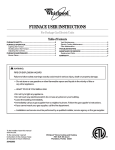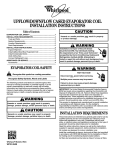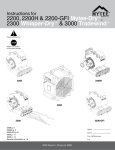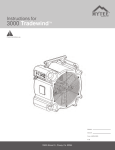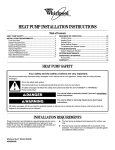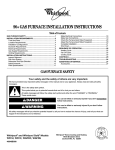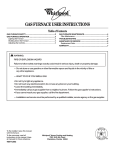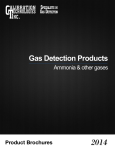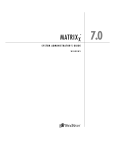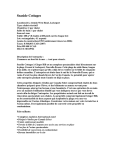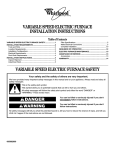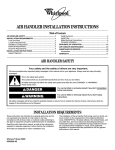Download Whirlpool ED5FHAXVB00 Instruction manual
Transcript
EVAPORATOR COIL INSTALLATION INSTRUCTIONS Table of Contents EVAPORATOR COIL SAFETY .......................................................1 INSTALLATION REQUIREMENTS ................................................2 Tools and Parts ............................................................................2 System Requirements..................................................................2 Location Requirements................................................................2 Drain Requirements .....................................................................2 INSTALLATION INSTRUCTIONS ..................................................2 Inspect Shipment .........................................................................2 Prepare Evaporator Coils.............................................................3 Verify Orifice Size .........................................................................3 Assemble Distributor/Orifice ........................................................3 Install Evaporator Coil ..................................................................4 Install Auxiliary Drain Pan.............................................................5 Install Condensate Drains ............................................................5 Connect Refrigerant Lines ...........................................................6 ASSISTANCE OR SERVICE ...........................................................6 Accessories ..................................................................................6 WARRANTY ....................................................................................7 EVAPORATOR COIL SAFETY Your safety and the safety of others are very important. We have provided many important safety messages in this manual and on your appliance. Always read and obey all safety messages. This is the safety alert symbol. This symbol alerts you to potential hazards that can kill or hurt you and others. All safety messages will follow the safety alert symbol and either the word “DANGER” or “WARNING.” These words mean: You can be killed or seriously injured if you don't immediately follow instructions. You can be killed or seriously injured if you don't follow instructions. All safety messages will tell you what the potential hazard is, tell you how to reduce the chance of injury, and tell you what can happen if the instructions are not followed. The California Safe Drinking Water and Toxic Enforcement Act requires the Governor of California to publish a list of substances known to the State of California to cause cancer, birth defects, or other reproductive harm, and requires businesses to warn of potential exposure to such substances. WARNING: This product contains a chemical known to the State of California to cause cancer, birth defects, or other reproductive harm. This appliance can cause low-level exposure to one of the substances listed: formaldehyde. 065638101 INSTALLATION REQUIREMENTS These instructions are intended as a general guide only and do not supersede any national or local codes in any way. Compliance with all local, state, or national codes pertaining to this type of equipment should be determined prior to installation. Read this entire instruction manual, as well as the instructions supplied in separate equipment, before starting the installation. All models are designed for indoor installation only. Install the conditioned air plenum, ducts and air filters (not provided) in accordance with NFPA 90B Standard for the Installation of Warm Air Heating and Air-Conditioning Systems (latest edition). Air Filters must be listed as Class 2 furnace air filters. Tools and Parts Assemble the required tools and parts before starting installation. Tools Needed: ■ Torch ■ ¹⁄₄ in. Nut driver ■ Tape measure ■ ¹³⁄₁₆ in. Open end wrench ■ Flat-blade screwdriver ■ Level Parts Needed: Check local codes. Read this entire instruction manual, and check existing drain configuration before purchasing parts. ■ Field fabricated auxiliary drain pan (in some installations) Parts Supplied: Evaporator coil may be provided as a separate coil or mounted in a duct extension. Location Requirements When the evaporator coil is installed in an attic, above a finished ceiling, or in any location where condensate overflow would result in property damage, the installer must provide an auxiliary drain pan in addition to the primary and secondary drains. The auxiliary drain pan must be connected to a drainage system separate from the primary condensate drain. Drain Requirements ■ All vertical mount models come from the factory with right and left front drain connections. ■ Multiposition models come from the factory with right and left front drain connections for vertical installations and left front drain connections when installed in the horizontal position. ■ Minimum ¾ in. copper or PVC drain lines are recommended. NOTE: Check local codes before connecting drain lines to an existing drainage system. ■ A field-fabricated auxiliary drain pan, with a drainpipe to the outside of the building, is required in all installations over a finished living space or in any area that may be damaged by overflow from the main drain pan. In some localities, local codes may require an auxiliary drain pan for any horizontal installation. INSTALLATION INSTRUCTIONS Inspect Shipment ■ System Requirements IMPORTANT: ■ The blower and duct system must be properly sized in order to provide adequate cooling and heating performance. For proper cooling operation, the airflow through the indoor coil should be between 350 - 450 CFM per ton of cooling capacity (or 350 - 450 CFM per 12,000 BTU/H) based on the rating of the outdoor unit. ■ All air passing over the evaporator coil must be filtered. ■ Evaporator coils are matched to specific outdoor units to obtain an ARI rating. The orifice installed on each evaporator coil is chosen for the BTU/H capacity of the coil. The factory installed orifice size is stamped on the orifice body, and is identified with a label on the orifice extension stub. The orifice size must match the size called for on the refrigerant charging table found on the outdoor unit. A selection of replacement orifices is available from the distributor. 2 WARNING Excessive Weight Hazard Use two or more people to move and install evaporator coil. Failure to do so can result in back or other injury. 1. Check the unit rating plate to confirm specifications are as ordered. 2. Upon receipt of equipment, carefully inspect it for possible shipping damage. Take special care to examine the unit inside the carton if the carton is damaged. If damage is found, it should be noted on the carrier’s freight bill. Damage claims should be filed with the carrier immediately. Claims of shortages should be filed with the seller within 5 days. NOTE: If any damages are discovered and reported to the carrier, do not install the unit, because your claim might be denied. Prepare Evaporator Coils Assemble Distributor/Orifice IMPORTANT: ■ This evaporator coil was manufactured containing a dry air precharge of 10 psi. Slowly remove the rubber line seal plugs to relieve the dry air precharge pressure. 1. Remove brass hex nut from distributor/orifice assembly. 2. Remove line seal plug from the orifice assembly. 3. Unscrew and remove shipping strap from orifice extension stub. Remove orifice extension stub from panel. 4. Relocate the ring seal to the stub end of the orifice extension stub as shown. ■ Before installation, carefully wash the coil finned areas with a mild soap solution to remove shipping and handling contamination. Orifice Extension Stub - Before removal of shipping strap Uncased Evaporator Coil 1 2 1 2 3 1. Orifice extension stub 2. Remove shipping strap 3. Ring seal 3 Orifice Extension Stub - After removal of shipping strap 4 1 2 5 6 1. Orifice extension stub 2. Ring seal 5. Slide the brass hex nut over the orifice extension stub. 6 3 1 8 4 7 1. Suction line header 2. Line seal plug 3. Orifice extension stub 4. Distributor/Orifice assembly 5. Drain pan 6. Primary drain connections 7. Drain plugs 8. Secondary drain connection Cased Evaporator Coil Verify Orifice Size IMPORTANT: The proper orifice size is dependent on indoor coil/ outdoor unit combination and application. Consult the outdoor unit information to determine if the indoor unit has the correct orifice installed. 5 6 2 1. Distributor fitting 2. Mounting flange 3. Piston orifice 4. Ring seal (supplied) 5. Orifice extension stub 6. 0.812 in. Brass hex nut 6. If a change in orifice is required, remove the factory-installed orifice with an orifice extractor tool. 7. Insert the proper orifice into the fitting, seal end first. Make sure the orifice is free to move in the fitting. 8. Assemble the brass hex nut and orifice extension stub onto the distributor/orifice assembly as shown. NOTE: Overtightening the brass hex nut will crush the gasket and might result in a system leak or stuck piston 9. Dispose of all packaging and unused parts. 3 Counterflow (Downflow) Models Install Evaporator Coil IMPORTANT: ■ The evaporator coil must be installed in the discharge (supply) air of a gas or oil furnace. Do not install an evaporator coil in the return air, or excessive condensation will occur within the furnace. ■ Install the evaporator coil level with the drain connection to ensure proper drainage. ■ To prevent damage to the plastic drain pan, minimum spacing is required between the drain pan and a furnace heat exchanger. A minimum spacing of 2 in. is required for a gas furnace. A minimum spacing of 4 in. is required for an oil-fired furnace. See “Evaporator Coil Drain Pan Clearances.” ■ Metal air seals must be placed on the inside of the evaporator's drain pan to prevent water spray in all counterflow model installations as shown. Air Seal Kit, Part No. ACFAIRSEAL-1, is available. The kit contains 4 air seals, enough to complete 2 counterflow installations. Air Seal Installation (Counterflow Models Only) Evaporator Coil Drain Pan Clearances 2 2 Gas 2" Minimum Oil-fired 4" Minimum 1 1. Air seals before installation 2. Air seals installed 1 1. Furnace heat exchanger 2. Plastic drain pan ■ If the plenum duct work is larger than the drain pan in any direction, the gaps between the drain pan and the plenum walls must be closed off to prevent bypass of air around the sides of the drain pan. Use field fabricated sheet metal angles wide enough to support the coil where the drain pan is located and attach them to the inside of the plenum. The drain pan will rest on the metal angles. If the connection between the plenum and any duct occurs below the apex of the coil, seal this seam with sealant. Installing Air Seals During Evaporator Coil Installation Install the air seals, hooking the top flange over the internal sides of the drain opening as shown. Side View of Drain Pan 1 2 1. Air seal 2. Drain pan NOTE: Not installing the air seals correctly may result in property damage due to condensate water being drawn into the furnace. 4 Installing Air Seals After Evaporator Coil Installation IMPORTANT: Evaporator coil assembly should not be removed after refrigerant lines have been connected and brazed. WARNING Install Auxiliary Drain Pan (If required) ■ See “Location Requirements” for furnace installation configurations that require an auxiliary drain pan. ■ Counterflow installations located directly over objects that can be damaged by condensate, such as in an installation on a second floor over a finished ceiling, require a auxiliary drain pan. ■ The auxiliary drain pan should be installed below the supply plenum. It should be at least 2 in. deep and at least 2 in. larger in all directions than the supply plenum. A separate drain line from the auxiliary drain pan to an open drain should be provided. ■ The open drain should be visible so that any water coming from the auxiliary drain can be seen as an indicator that the primary drain is plugged, which should be investigated and corrected. Electrical Shock Hazard Disconnect power before servicing. Replace all parts and panels before operating. Failure to do so can result in death or electrical shock. 1. Disconnect power. 2. Remove evaporator coil assembly from the furnace. 3. Install the air seals, hooking the top flange over the internal sides of the drain opening as shown. Side View of Drain Pan 1 2 1. Air seal 2. Drain pan NOTE: Not installing the air seals correctly may result in property damage due to condensate water being blown into the supply duct. Install Condensate Drains The evaporator coil is provided with ³⁄₄ in. NPT condensate drain connections. Make sure unit is level with the drain opening so that the drain pan will empty completely without water standing in the pan. 1. Connect primary drain line connection to the drain pan (large hole). 2. Connect secondary drain line connection to the drain pan (small hole). Route the secondary drain to empty at a location easily seen, so that any drainage coming from that line would be noticed. If there is drainage from the secondary drain line, a problem exists with the primary drain system, which should be investigated and corrected. NOTE: Use thread sealant on drain pan fittings. Install drain lines hand tight. Do not overtighten. 4. Reinstall evaporator coil assembly. 5. Reconnect power. 5 3. Install a 3 in. trap in both the primary and secondary drain lines as close to the unit as practical. Make sure the top of the trap is below the connection to the drain pan to allow complete drainage of the pan. NOTE: Horizontal runs over 15 ft long must also have an antisiphon air vent (standpipe) installed ahead of the horizontal run. See “Typical Condensate Drain Connection.” An extremely long horizontal run may require an oversized drain line to eliminate air trapping. Typical Condensate Drain Connection (secondary drain not shown) 2 1 3 4 1.00" Min. 12.00" Max. 3.00" Min. 5 1. Evaporator coil 2. Drain connection 3. Drain line 4. Anti-siphon air vent (for horizontal runs of 15 ft or longer) 5. Drain trap NOTE: Do not install evaporator coil without a drain trap. The condensate drain is on the negative pressure side of the blower; therefore, air being pulled through the condensate line will prevent positive drainage without a proper trap. 4. Route the drain line to the outside or to an appropriate drain. Drain lines must be installed so they do not block service access to the front of the evaporator coil. A 24 in. clearance is required for filter, coil, or blower removal and service access. NOTE: Check local codes before connecting the drain line to an existing drainage system. 5. Insulate the drain lines where sweating could cause water damage. Connect Refrigerant Lines Refrigerant lines must be connected by a licensed, EPA certified refrigerant technician in accordance with established procedures. IMPORTANT: Connecting refrigerant lines must be clean, dehydrated, refrigerant-grade copper lines. Evaporator coils should be installed only with specified line sizes for approved system combinations. Use care with the refrigerant lines during the installation process. Sharp bends or possible kinking in the lines will cause a restriction. Do not remove the caps from the lines or system connection points until connections are ready to be completed. 1. Route the suction and liquid lines from the fittings on the indoor coil to the fittings on the outdoor unit. Run the lines in as direct a path as possible, avoiding unnecessary turns and bends. 2. Ensure that the suction line is insulated over the entire exposed length and that both suction and liquid lines are not in direct contact with floors, walls, duct work, floor joists, or other piping. 3. Connect the suction and liquid lines to the evaporator coil. 4. To avoid damaging the rubber grommets in the cabinet while brazing, slide the rubber grommets over the refrigerant lines until they are away from the heat source. 5. Braze with an alloy of silver or copper and phosphorus with a melting point above 1,100°F. NOTE: Do not use soft solder. 6. Reinstall the rubber grommets after brazing is finished. 7. Make sure outdoor unit has been put in place according to the Installation Instructions and is connected to the refrigerant lines. ASSISTANCE OR SERVICE Test condensate drain pan and drain line after installation: 1. Pour several quarts of water into drain pan, enough to fill drain trap and line. 2. Check to make sure the drain pan is draining completely, no leaks are found in drain line fittings, and water is draining from the end of the primary drain line. 3. Correct any leaks found. If you need further assistance, you can write to the below address with any questions or concerns: Whirlpool® Home Cooling and Heating 7901 S.W. 6th Court Plantation, Florida 33324 Please include a daytime phone number in your correspondence. Accessories To order accessories, ask for the appropriate part number listed below or contact your Whirlpool® Home Cooling and Heating dealer. ACFAIRSEAL-1 6 Air Seals (4) - for 2 installations 7 Keep this book and your sales slip together for future reference. You must provide proof of purchase or installation date for in-warranty service. Write down the following information about your unit to better help you obtain assistance or service if you ever need it. You will need to know the complete model and serial number. You can find this information on the unit rating plate. Dealer name____________________________________________________ Address ________________________________________________________ Phone number __________________________________________________ Model number __________________________________________________ Serial number __________________________________________________ Installation date ________________________________________________ 065638101 © 2003. All rights reserved. ®/TM Whirlpool and all other trademarks are owned by Whirlpool, U.S.A., used under license by Tradewinds Distributing Company, LLC. 4/03 Printed in U.S.A.








